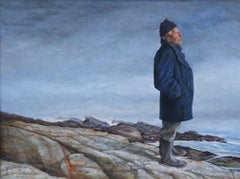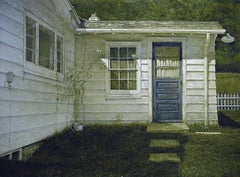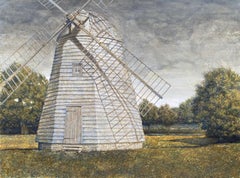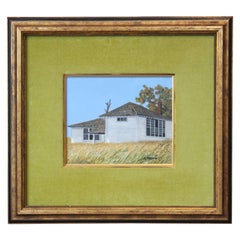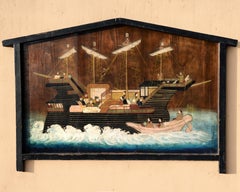Michael Kotasek Paintings
to
6
3
2
1
1
1
2
2
Overall Height
to
Overall Width
to
4
2
2
2
2
2
2
1
1
1
1
1
1
1
1
1
1
1
1
1
6
14
860
658
647
610
6
5
5
1
1
Artist: Michael Kotasek
Montauk
By Michael Kotasek
Located in Sag Harbor, NY
Awards
2013 Loring W. Coleman Award for Watercolor/ Allied Artists of America, 100th Annual Exhibition at the National Arts Club
2011 Mary Bryan Memorial Medal / Allied Artis...
Category
21st Century and Contemporary American Realist Michael Kotasek Paintings
Materials
Egg Tempera
Down Easter
By Michael Kotasek
Located in Sag Harbor, NY
Awards
2013 Loring W. Coleman Award for Watercolor/ Allied Artists of America, 100th Annual Exhibition at the National Arts Club
2011 Mary Bryan Memorial Medal / Allied Arti...
Category
21st Century and Contemporary American Realist Michael Kotasek Paintings
Materials
Egg Tempera
Metaphysics
By Michael Kotasek
Located in Sag Harbor, NY
Awards
2013 Loring W. Coleman Award for Watercolor/ Allied Artists of America, 100th Annual Exhibition at the National Arts Club
2011 Mary Bryan Memorial Medal / Allied Artis...
Category
21st Century and Contemporary American Realist Michael Kotasek Paintings
Materials
Oil
Afternoon Sun
By Michael Kotasek
Located in Sag Harbor, NY
Awards
2013 Loring W. Coleman Award for Watercolor/ Allied Artists of America, 100th Annual Exhibition at the National Arts Club
2011 Mary Bryan Memorial Medal / Allied Artis...
Category
Early 2000s American Realist Michael Kotasek Paintings
Materials
Egg Tempera
Breakwater
By Michael Kotasek
Located in Sag Harbor, NY
Awards
2013 Loring W. Coleman Award for Watercolor/ Allied Artists of America, 100th Annual Exhibition at the National Arts Club
2011 Mary Bryan Memorial Medal / Allied Artis...
Category
21st Century and Contemporary American Realist Michael Kotasek Paintings
Materials
Egg Tempera
“The Village Green”
By Michael Kotasek
Located in Southampton, NY
Egg tempera on board original painting of the Watermill, New York windmill and green by the well known American realist painter, Michael Kotasek. Signed lower right. Titled and dated...
Category
Early 2000s American Realist Michael Kotasek Paintings
Materials
Egg Tempera, Board
Related Items
Untitled Acrylic Architectural Landscape Painting
By Anthony V. Martin
Located in Houston, TX
Architectural landscape painting by Anthony V. Martin of a white house with a lovely green velvet mat and a gold frame.
Artist Biography: Anthony V. Martin grew up in east Texas. H...
Category
1960s Modern Michael Kotasek Paintings
Materials
Egg Tempera
H 15 in W 16.5 in D 1.5 in
Large Japanese Wood Board Ema Namban Depicting a Portuguese Ship Edo period
Located in Stockholm, SE
An Ema is a votive plaque people hang in a "dedication area", at a Shinto shrine, with their wish to the gods. Wishes usually would revolve around health, love, career, prosperity, a...
Category
Mid-19th Century Realist Michael Kotasek Paintings
Materials
Wood, Tempera, Egg Tempera, Wood Panel
Pikes Peak, 1940s Colorado Mountain Landscape in Autumn, Tempera Painting
By Charles Ragland Bunnell
Located in Denver, CO
Original vintage 1941 Colorado landscape painting with autumn leaves and Pikes Peak blanketed in snow by Charles Bunnell (1897-1968). Inscribed verso, "To Laura, November 22, 1941", egg tempera on board. Signed by the artist in the lower left corner and titled verso. Presented in a custom frame, outer dimensions measure 15 ½ x 19 ¼ x 1 ¼ inches. Image size is 7 ¾ x 11 inches
About the Artist:
Artist and teacher, Charles ("Charlie") Bunnell worked in a variety of styles throughout his career because as an artist he believed, "I’ve got to paint a thousand different ways. I don’t paint any one way." At different times he did representational landscapes while concurrently involved with semi- or completely abstract imagery. He was one of a relatively small number of artists in Colorado successfully incorporating into their work the new trends emanating from New York and Europe after World War II. During his lifetime he generally did not attract a great deal of critical attention from museums, critics and academia. However, he personally experienced a highpoint in his career when Katherine Kuh, curator at the Art Institute of Chicago, personally chose one of his paintings - Why? - for its large exhibition of several hundred examples of abstract and surrealist art held in 1947-48, subsequently including it among the fifty pieces selected for a traveling show to ten other American museums.
An only child, Bunnell developed his love of art at a young age through frequent drawing and political cartooning. In high school he was interested in baseball and golf and also was the tennis champion for Westport High School in Kansas City. Following graduation, his father moved the family to Denver, Colorado, in 1916 for a better-paying bookkeeping job, before relocating the following year to Colorado Springs to work for local businessman, Edmond C. van Diest, President of the Western Public Service Company and the Colorado Concrete Company. Bunnell would spend almost all of his adult life in Colorado Springs.
In 1918 he enlisted in the United States Army, serving in the 62nd Infantry Regiment through the end of World War I. Returning home with a 10% disability, he joined the Zebulon Pike Post No. 1 of the Disabled American Veterans Association and in 1921 used the benefits from his disability to attend a class in commercial art design conducted under a government program in Colorado Springs. The following year he transferred to the Broadmoor Art Academy (founded in 1919) where he studied with William Potter and in 1923 with Birger Sandzén. Sandzén’s influence is reflected in Bunnell’s untitled Colorado landscape (1925) with a bright blue-rose palette.
For several years thereafter Bunnell worked independently until returning to the Broadmoor Art Academy to study in 1927-28 with Ernest Lawson, who previously taught at the Kansas City Art Institute where Bunnell himself later taught in the summers of 1929-1930 and in 1940-41. Lawson, a landscapist and colorist, was known for his early twentieth-century connection with "The Eight" in New York, a group of forward-looking painters including Robert Henri and John Sloan whose subject matter combined a modernist style with urban-based realism. Bunnell, who won first-place awards in Lawson’s landscapes classes at the Academy, was promoted to his assistant instructor for the figure classes in the 1928-29 winter term. Lawson, who painted in what New York critic James Huneker termed a "crushed jewel" technique, enjoyed additional recognition as a member of the Committee on Foreign Exhibits that helped organize the landmark New York Armory Exhibition in 1913 in which Lawson showed and which introduced European avant-garde art to the American public.
As noted in his 1964 interview for the Archives of American Art in Washington, DC, Bunnell learned the most about his teacher’s use of color by talking with him about it over Scotch as his assistant instructor. "Believe me," Bunnell later said, "[Ernie] knew color, one of the few Americans that did." His association with Lawson resulted in local scenes of Pikes Peak, Eleven Mile Canyon, the Gold Cycle Mine near Colorado City and other similar sites, employing built up pigments that allowed the surfaces of his canvases to shimmer with color and light. (Eleven Mile Canyon was shown in the annual juried show at the Carnegie Institute in Pittsburgh in 1928, an early recognition of his talent outside of Colorado.) At the same time, he animated his scenes of Colorado Springs locales by defining the image shapes with color and line as demonstrated in Contrasts (1929). Included in the Midwestern Artists’ Exhibition in Kansas City in 1929, it earned him the gold medal of the Kansas City Art Institute, auguring his career as a professional artist.
In the 1930s Bunnell used the oil, watercolor and lithography media to create a mini-genre of Colorado’s old mining towns and mills, subject matter spurned by many local artists at the time in favor of grand mountain scenery. In contrast to his earlier images, these newer ones - both daytime and nocturnal -- such as Blue Bird Mine essentially are form studies. The conical, square and rectangular shapes of the buildings and other structures are placed in the stark, undulating terrain of the mountains and valleys devoid of any vegetation or human presence. In the mid-1930s he also used the same approach in his monochromatic lithographs titled Evolution, Late Evening, K.C. (Kansas City) and The Mill, continuing it into the next decade with his oil painting, Pikes Peak (1942).
During the early 1930s he studied for a time with Boardman Robinson, director of the Broadmoor Art Academy and its successor institution, the Colorado Springs Fine Arts Center from 1930 to 1947. In 1934 Robinson gave him the mural commission under the Public Works of Art Project (PWAP) for West Junior High School in Colorado Springs, his first involvement in one of several New Deal art...
Category
1930s American Impressionist Michael Kotasek Paintings
Materials
Egg Tempera, Board
H 15.5 in W 19.25 in D 1.25 in
Knight’s Lodging
Located in Los Angeles, CA
This painting is part of our exhibition American Coast to Coast: Artists of the 1930s
Knight’s Lodging, 1941, oil on canvas panel, signed and dated lower left, 16 x 20 inches, exhi...
Category
1940s American Realist Michael Kotasek Paintings
Materials
Oil
Colliers Magazine 1947 American Scene Social Realism Modern Families in the Snow
Located in New York, NY
Colliers Magazine 1947 American Scene Social Realism Modern Families in the Snow
Katherine Wiggins (American 20th Century)
"The Shrimp"
20 x 24 inches
Egg tempera on masonite. c. 1...
Category
1940s American Realist Michael Kotasek Paintings
Materials
Egg Tempera, Masonite
Army Poker
Located in Los Angeles, CA
This work is part of our exhibition - America Coast to Coast: Artists of the 1940s
Army Poker, c. 1943, probably tempera on board, signed upper right, 16 x 20 inches, inscribed verso a) “Army Poker / Mervin Honig / 421 W 42 St. N.Y.C.,” b) “Mervin Honig / US Army Air Force – Seymour Johnson Field – Goldsboro, NC / Circa 1943,” and c) “(This painting was done before men was (sic) shipped off to the Mariana Islands (Saipan) The Second World War.” Note: four pencil sketches for this work included
Mervin Honig was a New York-based painter and illustrator who is best known for his realistic depictions of everyday life and sports themes. Honig was raised in Brooklyn and recalled almost never being without a paintbox in hand from the time he started elementary school. Honig had a deep reverence for the Old Master painters, Vermeer and Bellini, as well as the Americans Winslow Homer and Thomas Eakins. He initially studied art from 1939 through 1941 with Francis Criss. At the outbreak of World War II, Honig worked as a mechanic for Republic Aviation, but in August 1942, he enlisted in the US Army Air Corps and was stationed at Seymour Johnson Field in Goldsboro, North Carolina. During the war, Honig began to exhibit nationally, including as part of the Portrait of America exhibitions which originated at the Metropolitan Museum of Art and traveled around the country, as well as at the Carnegie Institute in Pittsburgh. He painted Army Poker in 1943 while stationed at Johnson Field. In this work, Honig draws inspiration from Paul Cezanne's The Card Players (Metropolitan Museum of Art), with a similar placement of the four figures, but Cezanne's table is replaced with an Army cot, the pipe rack with a soldier's mess kit and the drapery in the right background with a heap of discarded uniforms. Unlike the vibrancy of Cezanne's composition, the limited palette of Honig's work suggests the drabness and monotony of stateside Army life.
After being discharged from military service, Honig furthered his studies with Amadee Ozenfant in 1946 and Hans Hoffman from 1947 through 1950. Additional exhibitions included the Whitney Museum of American Art, the Brooklyn Museum, the Los Angeles County Museum of Art, the National Academy of Design, the Wadsworth Atheneum, the Provincetown Art Association, and the National Academies Galleries of the Allied Artists Association. He was represented by the venerable Frank Rehn...
Category
1940s American Realist Michael Kotasek Paintings
Materials
Oil, Board, Tempera
Antique American Impressionist Painting Red Riding Hood Framed 19th Century
Located in Buffalo, NY
An original antique American painting by Samuel Knight Wright, depicting the fairytale character of "Little Red Riding Hood" on her way to gr...
Category
Late 19th Century American Realist Michael Kotasek Paintings
Materials
Oil, Canvas
"Autumn Season Wetlands" Dreamy American Oil Painting Landscape on Board
By Kristina Nemethy
Located in New York, NY
A fine depiction of an autumn season landscape of Wetlands with a beautiful reflection of sunlight hitting the water. For this wonderful depiction, Nemethy uses a fine technique whic...
Category
2010s American Realist Michael Kotasek Paintings
Materials
Oil, Board
H 13 in W 19 in D 0.5 in
Bathers 1940s Mid 20th Century American Scene Social Realism WPA Modern Ashcan
Located in New York, NY
Bathers 1940s Mid 20th Century American Scene Social Realism WPA Modern Ashcan
Marion Gilmore (1909-1984)
Bathers
15 1/2 x 19 1/2 inches
oil on canvas boar...
Category
1940s American Realist Michael Kotasek Paintings
Materials
Oil, Board
Rare Catherine Koenig Nude Female Artist American Trompe L'oeil Pastel Pink
By Catherine Koenig
Located in Buffalo, NY
A Modern realist “trompe l’oeil” egg tempera painting by American female artist Catherine Catanzaro Koenig depicting a painting of a nude held up by masking tape. Koenig inspired by Magritte, creates captivating works that delight the eye.
Catherine C. Koenig was born Caterina Catanzaro in 1921 and grew up on the West side of Buffalo, NY. She graduated from Lafayette High School Buffalo in 1939. She exhibited a talent for drawing and painting early on and attended Albright Art School, where she graduated with an Associate's Degree in 1942.
Her professional career as an artist began in the 1940s when she started to exhibit her work. From 1946-1956, she taught drawing and painting at the Art Institute of Buffalo. She married Buffalo artist...
Category
1980s Realist Michael Kotasek Paintings
Materials
Tempera, Board, Egg Tempera, Wood
Industry and Commerce
Located in Los Angeles, CA
This mural study is part of our exhibition America Coast to Coast: Artists of the 1930s
Industry and Commerce, 1936, tempera on panel, 16 ½ x 39 ½ inches, signed verso “John Ballator, Portland Ore.” provenance includes: J.C. Penney Company, represented by Russell Tether Fine Arts Assoc.; presented in a newer wood frame
About the Painting
Industry and Commerce is a prime example of WPA Era muralism. Like a Mediaeval alter, this mural study is filled with icons, but the images of saints and martyrs are replaced with symbols of America's gospel of prosperity through capitalism. Industry and Commerce has a strong narrative quality with vignettes filling the entire surface. Extraction, logistics, design, power generation, and manufacturing for printing, chemicals, automobiles and metal products are all represented. To eliminate any doubt about the mural's themes, Ballator letters a description into the bottom of the study. Ballator also presents an idealized version of industrial cooperation, as his workers, lab-coated technicians and tie-wearing managers work harmoniously toward a common goal in the tidy and neatly designed environments. Although far from the reality of most industrial spaces, Ballator's study reflects the idealized and morale boosting tone that many mural projects adopted during the Great Depression.
About the Artist
John R Ballator achieved success as a muralist, lithographer, and teacher during the Great Depression. Born in Oregon, he studied at the Portland Museum Art School, the University of Oregon and at Yale University where he received a Bachelor of Fine Art. In 1936, Ballator was commissioned to paint a mural panel for the new Department of Justice Building in Washington DC, an important project that spanned five years with several dozen artists contributing a total of sixty-eight designs. Ballator completed murals for the St. Johns Post Office and Franklin High School, both in Portland, Oregon. He also contributed to the 1938 murals at Nathan Hale School in New Haven, Connecticut. During the late 1930s, Ballator taught art for several years at Washburn College in Topeka, Kanas, where he completed a mural for the Menninger Arts & Craft Shop before accepting a professorship at Hollins College...
Category
1930s American Realist Michael Kotasek Paintings
Materials
Tempera
Antique Autumn Fall Landscape Pumpkin Harvest by Kennedy
Located in Buffalo, NY
Antique Autumn Fall Landscape Pumpkin Harvest by Andrew Dwight Kennedy. Framed. Signed.
Category
Early 20th Century American Realist Michael Kotasek Paintings
Materials
Board, Oil
Michael Kotasek paintings for sale on 1stDibs.
Find a wide variety of authentic Michael Kotasek paintings available for sale on 1stDibs. If you’re browsing the collection of paintings to introduce a pop of color in a neutral corner of your living room or bedroom, you can find work that includes elements of blue, purple and other colors. You can also browse by medium to find art by Michael Kotasek in paint, egg tempera, tempera and more. Not every interior allows for large Michael Kotasek paintings, so small editions measuring 10 inches across are available. Customers who are interested in this artist might also find the work of Harry Humphrey Moore, Lawrence Wilbur, and Donald Jurney. Michael Kotasek paintings prices can differ depending upon medium, time period and other attributes. On 1stDibs, the price for these items starts at $3,000 and tops out at $14,000, while the average work can sell for $11,000.

